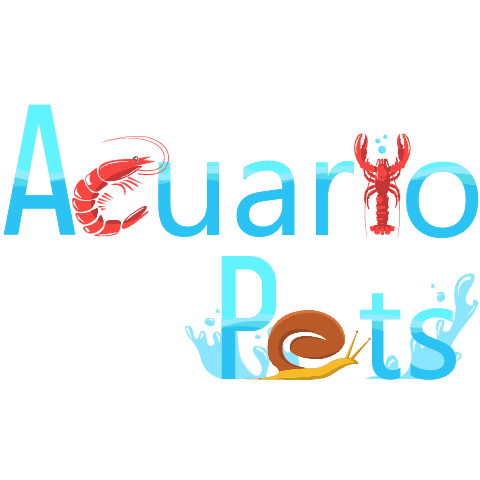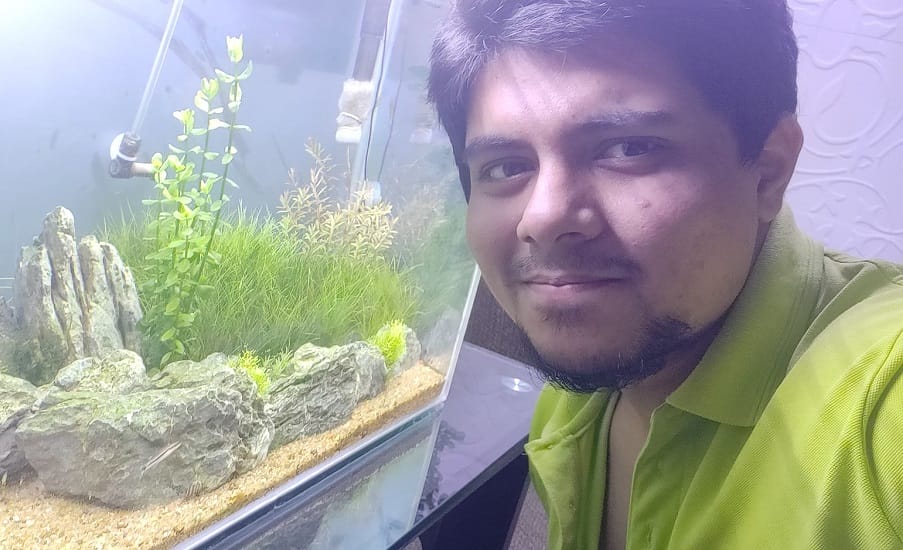This post was created with help from AI tools and carefully reviewed by a human (Muntaseer Rahman) . For more on how we use AI on this site, check out our Editorial Policy.
Check Out These FREE Tools We Made JUST For You!
How To Make A Bioactive Leopard Gecko Tank? [Step by Step]
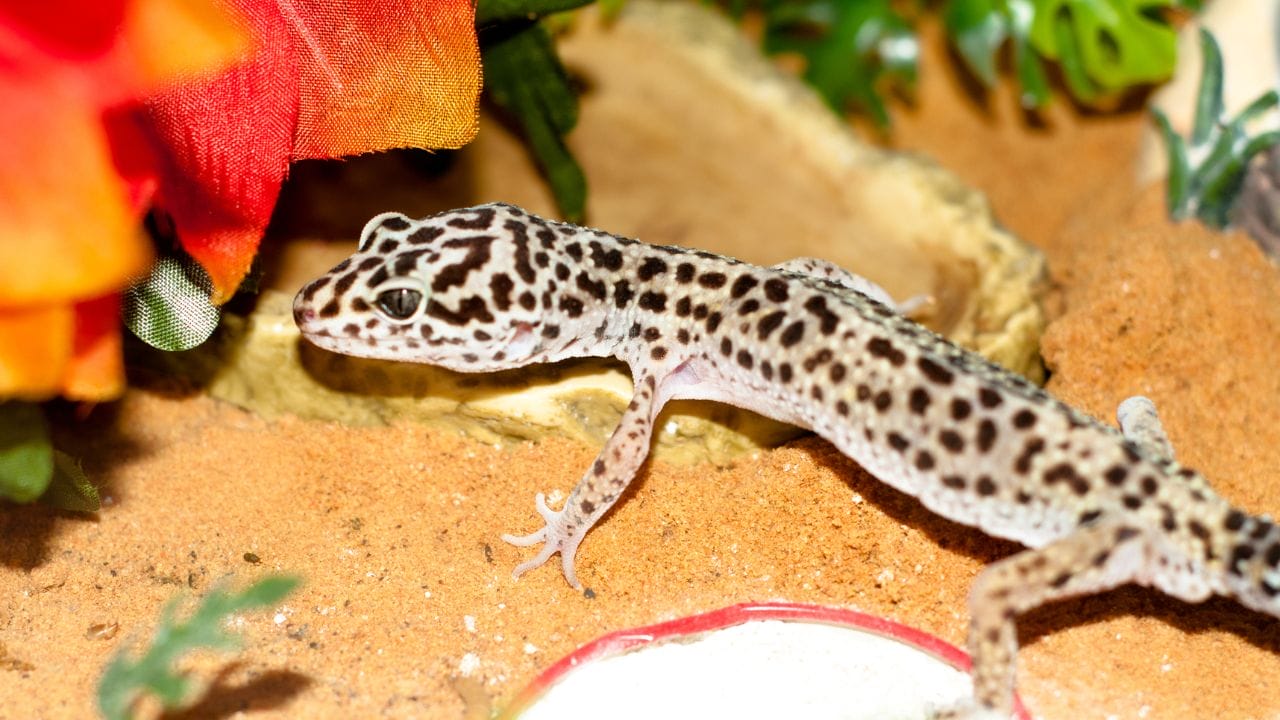
I used to dread cleaning my leopard gecko’s tank—scrubbing, swapping out substrate, the whole deal.
Then I discovered bioactive setups, and everything changed. Not only does my gecko love the more natural vibe, but the tank practically cleans itself.
If you’ve ever wondered how to make the switch, this step-by-step guide is exactly what I wish I had when I started.
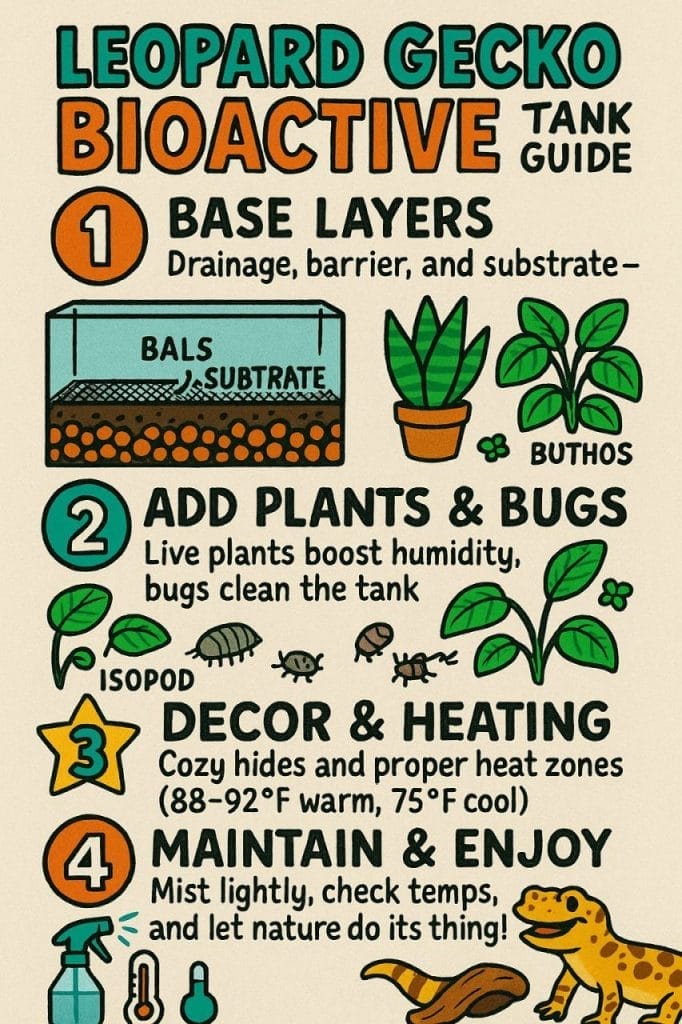
How Do You Set Up A Bioactive Leopard Gecko Tank?
Supplies You’ll Need
Before we get our hands dirty, let’s round up everything.
- Enclosure: At least 20 gallons long, but bigger is better. Leopard geckos love space to roam.
- Drainage layer: Clay balls (hydroballs) or lava rock. This keeps extra water away from the soil.
- Barrier mesh: Landscape fabric works fine. It stops the soil from mixing with the drainage layer.
- Substrate mix: Organic topsoil (no fertilizers), play sand, and leaf litter. You’re making a jungle floor here, not a sandbox.
- Live plants: Snake plants, pothos, or aloe. Hardy stuff that won’t die if your gecko steps on it.
- Clean-up crew: Springtails and isopods. These little bugs eat waste and keep the soil fresh.
- Decor: Hides, branches, rocks. Leopard geckos love a cozy cave and some climbing spots.
- Lighting and heating: A low-level UVB bulb (yes, leopard geckos can benefit from UVB) and a heat mat or heat lamp to keep one side warm.
Once you’ve got all this, it’s time to build.
Step 1: Set Up the Drainage Layer
This part is like giving your gecko’s tank rain boots. Water drains away so the soil doesn’t turn into a swamp.
- Spread about 1-2 inches of clay balls or lava rocks at the bottom of the tank.
- Shake the tank gently (or just pat it down) so it sits flat.
That’s it. Easy.
Step 2: Add a Barrier Layer
You don’t want the soil sinking into your drainage rocks. It’ll make a mess.
- Cut a piece of landscape fabric or mesh to fit over the drainage layer.
- Lay it flat so it covers everything.
This keeps the soil where it belongs.
Step 3: Prepare and Add the Substrate
Time to mix the perfect floor for your gecko.
- Grab organic topsoil and play sand—about 60% soil, 40% sand.
- Toss in some leaf litter if you have it. It helps with humidity and gives your clean-up crew something to munch on.
- Mix it up well.
Now, pour that mix on top of your barrier layer. Aim for about 3 inches deep so your gecko can dig if they feel like it.
Step 4: Introduce Live Plants
Plants are not just for looks. They help with humidity and make the setup feel natural.
- Dig little holes, place the plants in, and gently pack the soil around the roots.
- Don’t go overboard. Leave space for your gecko to roam.
Stick to tough plants like snake plants or pothos—stuff that survives even if your gecko bulldozes through them.
Step 5: Add Clean-Up Crew
This is where the magic happens. These tiny bugs do all the cleaning for you.
- Sprinkle springtails and isopods across the substrate.
- Give them a light misting to help them settle in.
They’ll eat leftover food, waste, and keep mold in check. Think of them as your gecko’s janitors.
You can find isopods and springtails at most reptile stores or online. They’re cheap and essential for any bioactive setup.
Step 6: Decorate with Hides and Climbing Features
Your gecko needs spots to chill.
- Add hides on both the warm and cool sides of the tank.
- Toss in some rocks, branches, or driftwood for climbing.
Make it feel wild but comfy. Don’t overcrowd the space—leave room for your gecko to explore.
Step 7: Set Up Lighting and Heating
Leopard geckos are desert creatures, but they need the right heat and light.
- Place a heat mat under one side of the tank or use a heat lamp.”Aim for a warm side around 88-92°F and a cool side around 75°F.
- Add a low-level UVB bulb. Even though they’re nocturnal, a little UVB helps their bones and overall health.
Check temperatures with a digital thermometer. No guessing here.
Step 8: Monitor and Maintain the Bioactive Setup
Here’s where you sit back and let nature do its thing—but keep an eye on it.
- Check humidity. It should hover around 30-40%, but slightly higher near plants.
- Mist lightly when needed. Not too much—you don’t want soggy soil.
- Watch your clean-up crew. They should thrive, but you can add more if their numbers drop.
After a while, your tank becomes its own little world. Less cleaning, happier gecko.
Don’t forget supplements. Even in a bioactive tank, your gecko still needs calcium and vitamins dusted on their feeders. The clean-up crew handles waste—not nutrition.
leopard gecko bioactive tank ideas

This leopard gecko bioactive tank shines with a desert-inspired layout filled with succulents, driftwood, and cork bark hides. The LED strip light on top brings out the lush greens and earthy tones, creating a lively yet cozy home for the gecko.

Packed with vibrant greenery and towering driftwood, this setup gives a jungle vibe with plenty of climbing spots and shaded hides. The moist substrate and overhead heat lamp ensure both humidity and warmth stay balanced for a healthy gecko habitat.
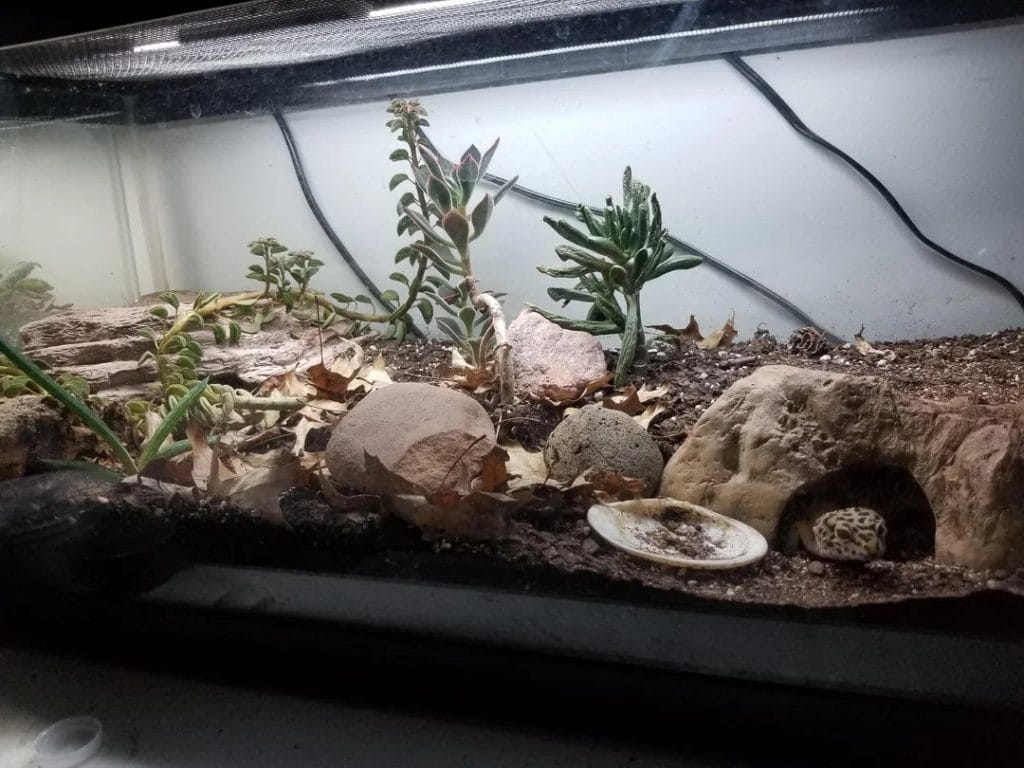
Simple and natural, this bioactive tank focuses on open space with scattered succulents, smooth rocks, and a large stone hide. The gecko can be seen resting inside the cave, enjoying the warm, dry environment with easy access to food and shelter.

This tank keeps it minimal with a sandy base, a large driftwood centerpiece, and a few succulents scattered around. It offers an open, airy space with a warm gradient from the heat lamp, giving the gecko plenty of room to roam and bask.
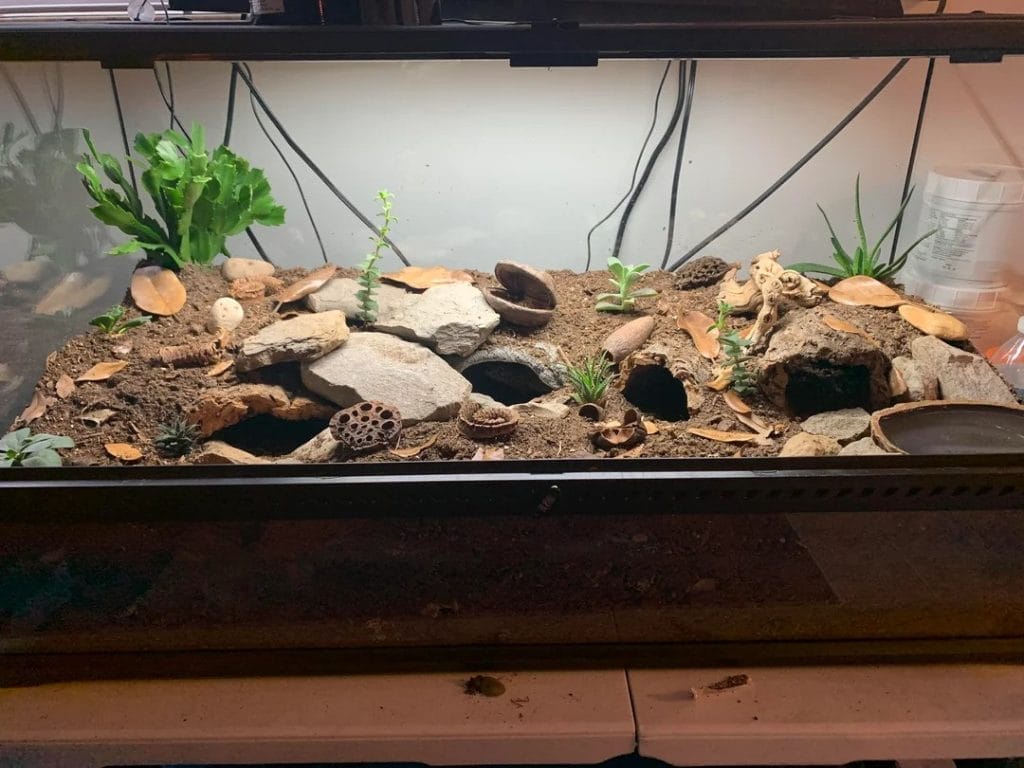
This setup uses flat stones and tunnels to create a natural desert hideaway. Sprinkled with leaf litter, succulents, and cozy burrows, it gives the gecko multiple spots to explore, climb, and hide, blending function with rustic beauty.
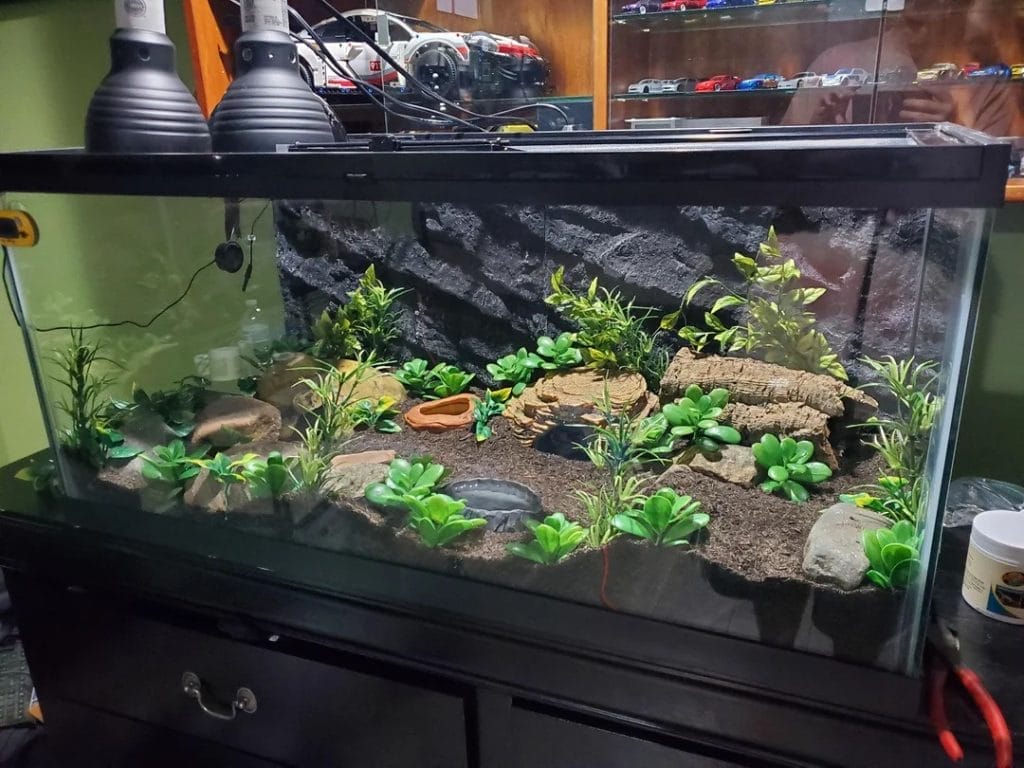
This lush bioactive tank packs in greenery with a mix of real and artificial plants. The layered background and scattered logs give it depth, while multiple hides and a moisture-retaining substrate create a perfect gecko paradise.

This enclosure feels like a miniature jungle with dense plant growth, mossy rocks, and layered cork bark. The mix of live plants and natural textures keeps humidity steady while offering the gecko shaded spots and hiding areas throughout.
Ready to Build Your Bioactive Tank?
You’ve got the steps. Now you need the gear.
From enclosures and substrate to heating and hides—we’ve put together a complete shopping list so you don’t have to hunt around.
👉 Check out our Leopard Gecko Owner Essentials for my tested recommendations on everything you need for a bioactive setup.
About Author
Hello, I’m Muntaseer Rahman, the owner of AcuarioPets.com. I’m passionate about aquarium pets like shrimps, snails, crabs, and crayfish. I’ve created this website to share my expertise and help you provide better care for these amazing pets.
Disclaimer
This site is owned and operated by Muntaseer Rahman. AcuarioPets.com is a participant in the Amazon Services LLC Associates Program, an affiliate advertising program designed to provide a means for sites to earn advertising fees by advertising and linking to Amazon.com. This site also participates in other affiliate programs and is compensated for referring traffic and business to these companies.
